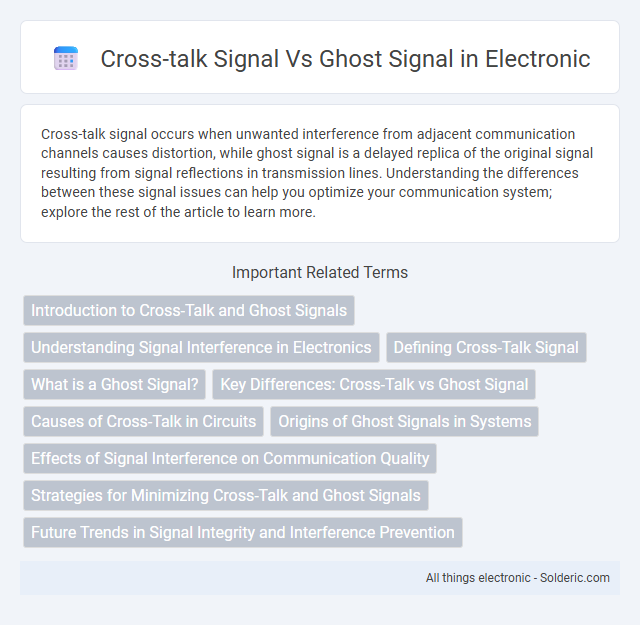Cross-talk signal occurs when unwanted interference from adjacent communication channels causes distortion, while ghost signal is a delayed replica of the original signal resulting from signal reflections in transmission lines. Understanding the differences between these signal issues can help you optimize your communication system; explore the rest of the article to learn more.
Comparison Table
| Feature | Cross-Talk Signal | Ghost Signal |
|---|---|---|
| Definition | Unintended interference caused by signal bleed between adjacent channels. | Secondary or delayed replica of the original signal appearing due to signal reflection or multipath. |
| Cause | Electromagnetic coupling or leakage between circuits or wires. | Signal reflections from obstacles, improper impedance matching, or multipath propagation. |
| Effect | Distorts original communication by mixing signals, causing noise & data errors. | Creates duplicate or delayed images of original signal, affecting clarity and timing. |
| Occurrence | Common in wired communication, PCB design, and radio systems. | Common in radar, sonar, and wireless communication systems with multipath environments. |
| Mitigation | Shielding, proper cable routing, isolation, and filtering techniques. | Use of absorbers, impedance matching, and signal processing algorithms. |
Introduction to Cross-Talk and Ghost Signals
Cross-talk signals occur when a signal transmitted on one channel or circuit creates interference on another, causing unwanted noise and degradation in communication systems. Ghost signals arise from multipath reflections where delayed replicas of the original signal overlap with the primary signal, leading to distorted images in television or blurred audio in communication channels. Both phenomena significantly impact signal clarity and require advanced filtering and isolation techniques to mitigate their effects in telecommunication and broadcasting.
Understanding Signal Interference in Electronics
Cross-talk signal arises when electromagnetic interference occurs between adjacent circuits or communication channels, causing unintended signal coupling. Ghost signal manifests as a replicated or delayed version of the original signal, typically due to multipath propagation or reflection within electronic systems. Understanding these interference types is crucial for designing circuits that minimize signal degradation and optimize Your system's overall performance.
Defining Cross-Talk Signal
Cross-talk signal refers to unwanted interference caused by the electromagnetic coupling between adjacent communication channels, leading to the leakage of signals from one channel into another. This phenomenon degrades signal integrity by introducing noise and distortion, which can compromise data transmission quality in wired and wireless systems. Unlike ghost signals, which result from signal reflections creating delayed duplicates, cross-talk specifically involves the direct transfer of signal energy between nearby circuits or channels.
What is a Ghost Signal?
A ghost signal is a delayed replica of the original signal caused by multipath interference, where reflected signals arrive at the receiver after the primary signal. It results in a faint, duplicated image or audio output that degrades broadcast quality in television and radio transmissions. Unlike cross-talk signals, which originate from unintended coupling between separate communication channels, ghost signals specifically arise from signal reflections in the transmission path.
Key Differences: Cross-Talk vs Ghost Signal
Cross-talk occurs when an unintended signal from one channel or circuit interferes with another, resulting in overlapping audio or data transmissions, while ghost signals are typically weaker, delayed reflections of the original signal caused by multipath propagation. Cross-talk affects signal clarity by mixing different sources simultaneously, whereas ghost signals produce duplicated or shifted images of the original signal. Understanding these key differences helps you diagnose and mitigate interference in communication or broadcasting systems effectively.
Causes of Cross-Talk in Circuits
Cross-talk in circuits primarily originates from capacitive and inductive coupling between adjacent conductors, where unwanted electromagnetic interference causes signal leakage. Narrow spacing, high-frequency signals, and improper shielding exacerbate this effect, leading to noise and signal distortion. Managing trace layout and implementing grounding techniques help reduce cross-talk, improving your circuit's signal integrity.
Origins of Ghost Signals in Systems
Ghost signals originate from multipath propagation where transmitted signals reflect off objects, causing delayed replicas to interfere with the main signal. Cross-talk signals arise from electromagnetic coupling between adjacent communication channels, leading to signal leakage and unwanted interference. Understanding the distinct origins of ghost and cross-talk signals is crucial for designing mitigation techniques in advanced communication systems.
Effects of Signal Interference on Communication Quality
Cross-talk signals cause unintended coupling between communication channels, leading to degraded audio clarity and increased bit error rates in data transmission. Ghost signals, resulting from signal reflections and multipath interference, produce delayed echoes that distort the original message and reduce overall communication quality. Both types of signal interference impair system reliability by introducing noise and reducing signal-to-noise ratio, critically affecting voice and data integrity.
Strategies for Minimizing Cross-Talk and Ghost Signals
Minimizing cross-talk and ghost signals involves optimizing cable shielding, maintaining proper cable separation, and using twisted-pair wiring to reduce electromagnetic interference in communication systems. Implementing filtering techniques and advanced signal processing algorithms helps in isolating desired signals from unwanted noise and reflections. Regular maintenance and testing ensure connectors and equipment integrity, further mitigating the impact of cross-talk and ghost signals in high-frequency transmission environments.
Future Trends in Signal Integrity and Interference Prevention
Future trends in signal integrity emphasize advanced materials and PCB design techniques to minimize cross-talk signal interference, enhancing high-speed data transmission reliability. Machine learning algorithms are increasingly employed to predict and mitigate ghost signals caused by unintended reflections or coupling in complex circuit environments. Emerging standards and adaptive filtering technologies aim to improve the robustness of communication systems against both cross-talk and ghost signal disruptions.
cross-talk signal vs ghost signal Infographic

 solderic.com
solderic.com